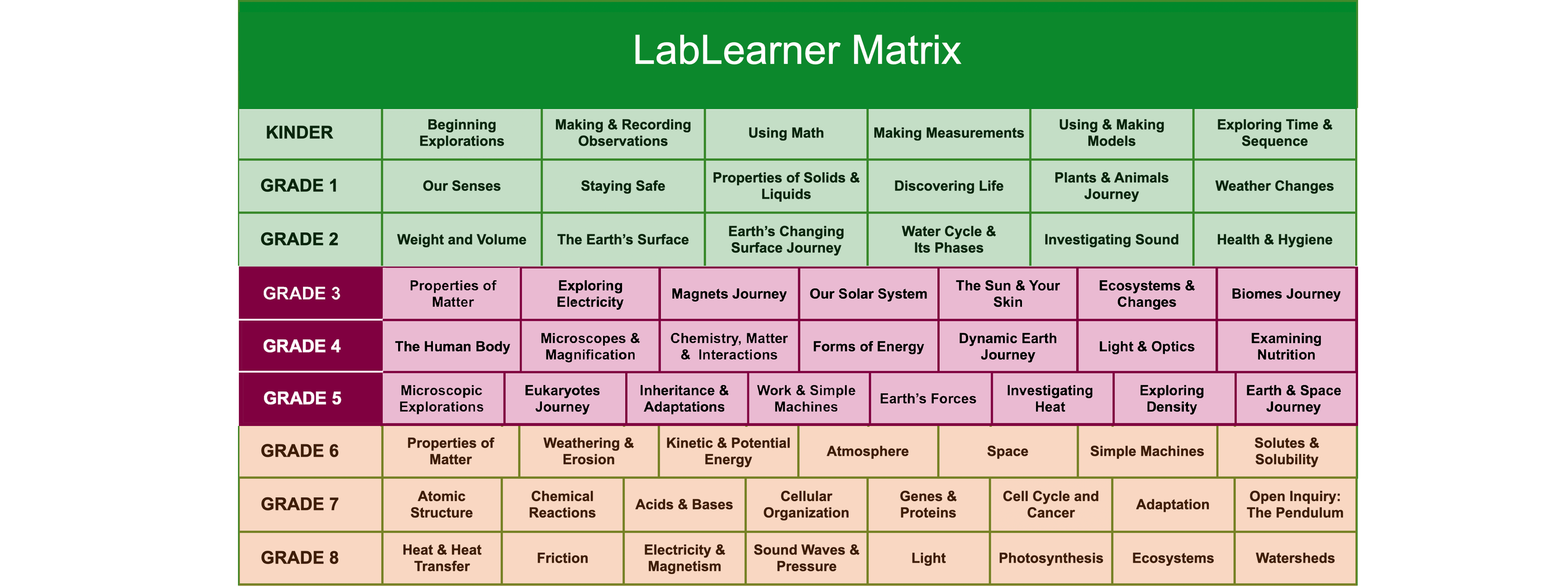LabLearner Explorer
LabLearner Explorer
Grades 3 through 5: Just the Right Time to Begin a Scientific Expedition!
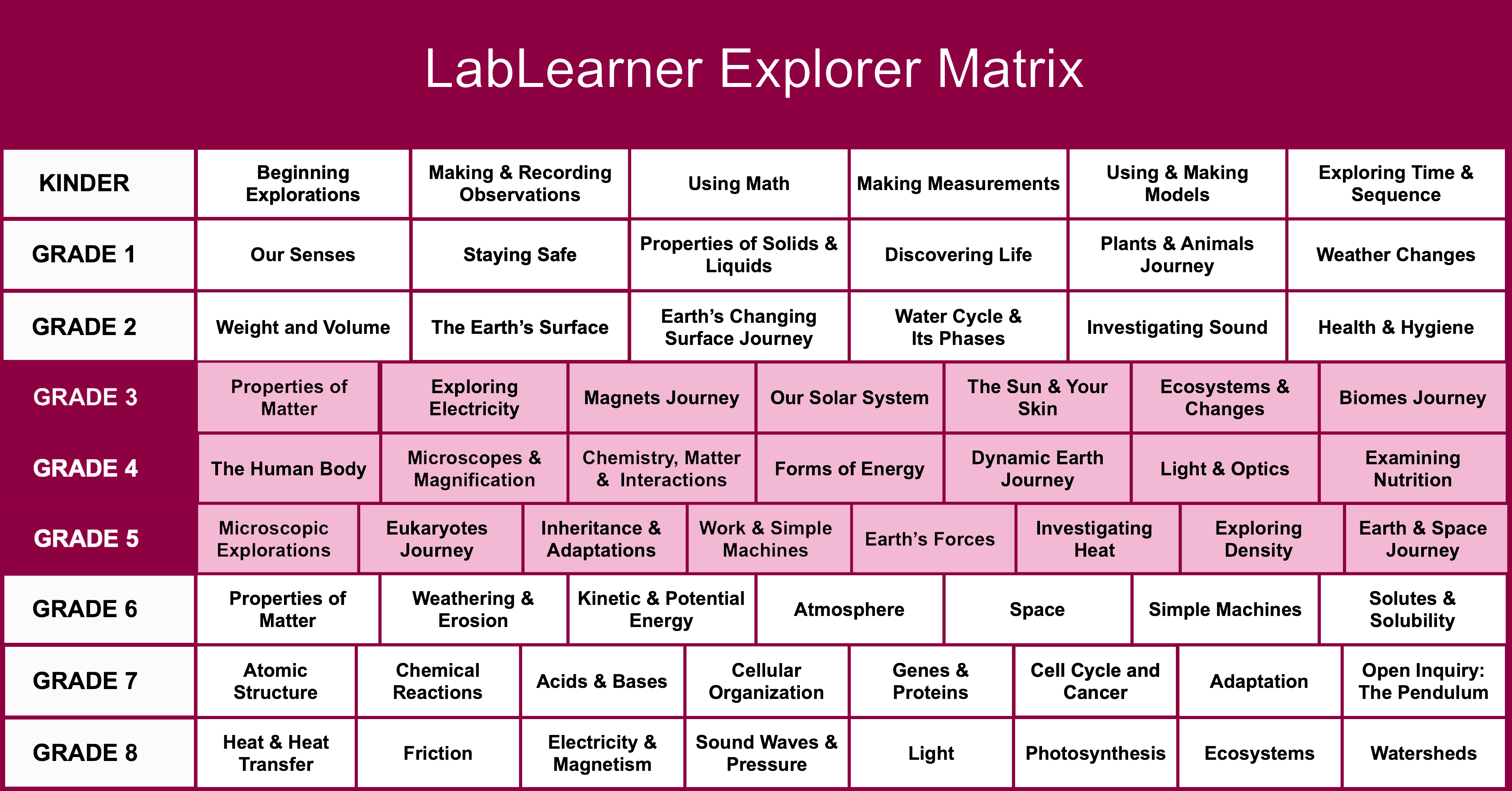 The LabLearner program has been developed and refined over a period of nearly two decades. The curriculum framework and details are based on neurocognitive data and human learning research. It has been successful in virtually every venue from rural farmlands across the midwest to urban centers like Chicago, New York, and Philadelphia. Based on this tremendous experience and success, we now we introduce LabLearner Explorer!
The LabLearner program has been developed and refined over a period of nearly two decades. The curriculum framework and details are based on neurocognitive data and human learning research. It has been successful in virtually every venue from rural farmlands across the midwest to urban centers like Chicago, New York, and Philadelphia. Based on this tremendous experience and success, we now we introduce LabLearner Explorer!
LabLearner Explorer is a truly exceptional gateway to authentic, hands-on science. LabLearner Explorer focuses on grades three through five CELL modules from our K-8 LabLearner science education system. Beginning with Properties of Matter in third grade through Exploring Density near the end of fifth grade, LabLearner Explorer serves up an unending diet of excitement and learning to the developing intermediate student mind.
What Makes This Just the Right Time for LabLearner Explorer?
Two Things: The Perfect Cognitive Moment in Development and a Clear Need for Vastly Improved STEM Success.
Let’s begin by addressing the reasons why LabLearner decided to ramp up its grades 3 through 5 curricula and offer it as an independent entrance portal to the entire LabLearner science education system.
The Perfect Cognitive Moment in Development
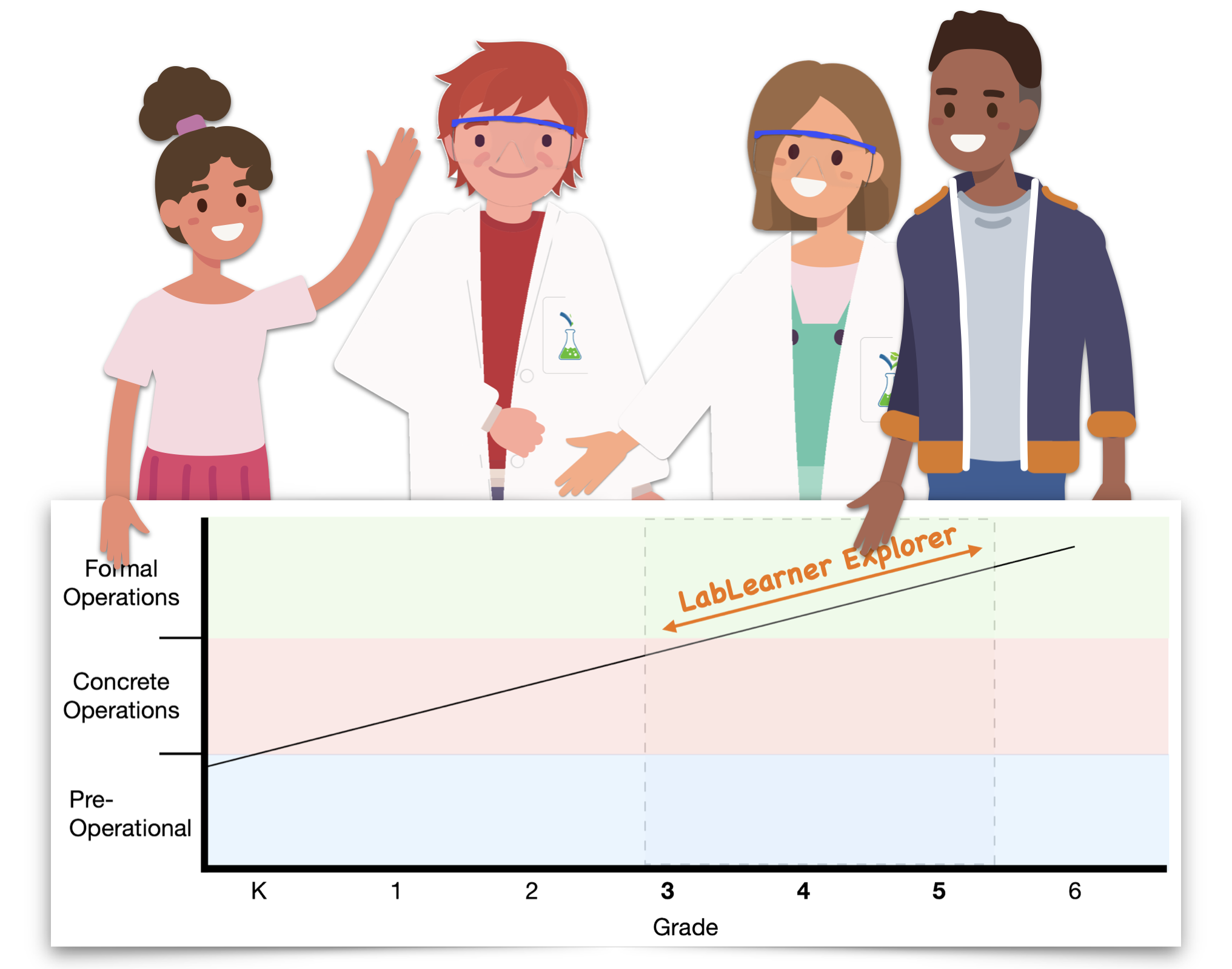 Consider where Intermediate students are in their cognitive and educational development. From a cognitive-developmental perspective, Intermediate students are making the transition from Concrete to Formal Operations. This transition establishes the ability to begin to think abstractly. Science is loaded with models and, in particular, hands-on science draws heavily on model representation so that abstract concepts can be reduced to the use of concrete manipulatives like beakers, test tubes, and magnets. Intermediate students are capable of beginning to understand simple models like representing steps in the water cycle, using levers to represent arm and leg joints, and colored gram cubes to represent nitrogenous bases in the DNA sequence.
Consider where Intermediate students are in their cognitive and educational development. From a cognitive-developmental perspective, Intermediate students are making the transition from Concrete to Formal Operations. This transition establishes the ability to begin to think abstractly. Science is loaded with models and, in particular, hands-on science draws heavily on model representation so that abstract concepts can be reduced to the use of concrete manipulatives like beakers, test tubes, and magnets. Intermediate students are capable of beginning to understand simple models like representing steps in the water cycle, using levers to represent arm and leg joints, and colored gram cubes to represent nitrogenous bases in the DNA sequence.
Spiraling Curriculum
LabLearner CELLs have been designed so that essential scientific themes spiral throughout the curriculum, taking into account the neurocognitive processing mechanisms of Intermediate students while remaining perfectly correlated with academic standards.
 Spiraling of scientific concepts maximizes the use of prior knowledge in understanding new, slightly more advanced information, in a way that presents a developing picture of essential scientific principles. Integrated repetition of basic concepts frees working memory to concentrate on new information in a logical context. This approach is entirely consistent with the National Research Council’s A Framework for K12 Science Education, which serve as a scaffolding for the development of the Next Generation Science Standards which states, “To develop a thorough understanding of scientific explanations of the world, students need sustained opportunities to work with and develop the underlying ideas and to appreciate those ideas’ interconnections over a period of years rather than weeks or months.” This is the precise logic behind LabLearner Explorer.
Spiraling of scientific concepts maximizes the use of prior knowledge in understanding new, slightly more advanced information, in a way that presents a developing picture of essential scientific principles. Integrated repetition of basic concepts frees working memory to concentrate on new information in a logical context. This approach is entirely consistent with the National Research Council’s A Framework for K12 Science Education, which serve as a scaffolding for the development of the Next Generation Science Standards which states, “To develop a thorough understanding of scientific explanations of the world, students need sustained opportunities to work with and develop the underlying ideas and to appreciate those ideas’ interconnections over a period of years rather than weeks or months.” This is the precise logic behind LabLearner Explorer.
LabLearner Explorer: Developing Mathematics and Language Competencies
While LabLearner Explorer is very tightly aligned with the Next Generation Science Standards, it also directly addresses a whole range of Mathematics and Language Arts standards and competencies. This, in turn, is related to the nature of the LabLearner Explorer collaborative group dynamic structure and the constant collection and mathematical analysis of data – real numbers obtained by doing real science experiments!
Mathematics
A LabLearner student was in the lab and trying to measure the distance around a lab stool – its circumference. He was using a meter stick, awkwardly trying to roll it around the perimeter. In frustration, he asked his teacher, “Isn’t there an easier way? Can’t we just measure the distance across the circle and 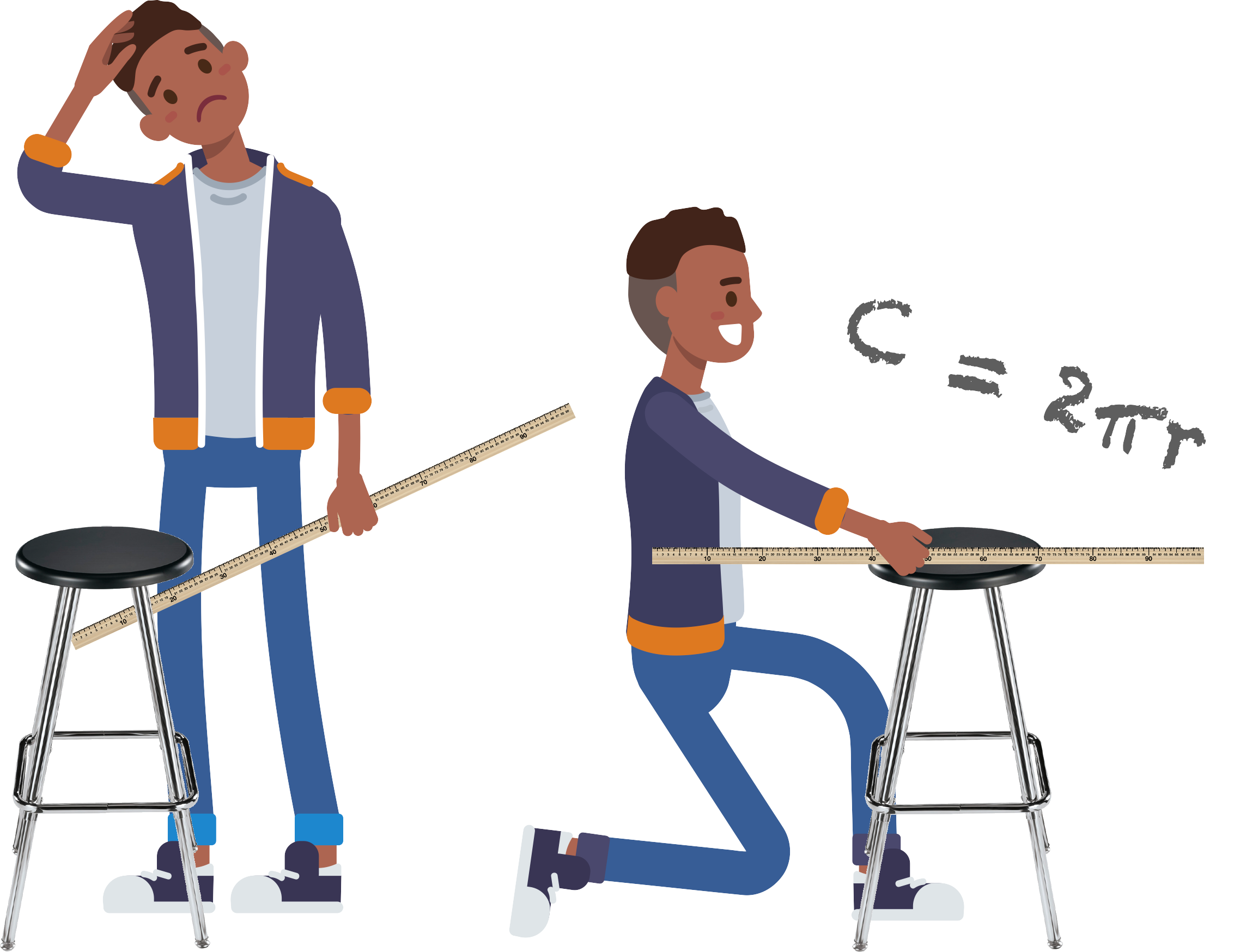 figure out the distance around it?“. The clever LabLearner teacher used the opportunity to teach the class C =2πr. The student gobbled up the simple solution, obtained accurate circumferences, and inadvertently learned about pi! This is one of many more examples of why and how science and mathematics need to be more thoughtfully integrated by the curriculum.
figure out the distance around it?“. The clever LabLearner teacher used the opportunity to teach the class C =2πr. The student gobbled up the simple solution, obtained accurate circumferences, and inadvertently learned about pi! This is one of many more examples of why and how science and mathematics need to be more thoughtfully integrated by the curriculum.
Intermediate students are uniquely in a position to benefit from the math/science formulation. By the Intermediate grades, students have achieved enough math exposure to at least be sensible about numbers. This allows them to benefit from LabLearner Explorer’s continual data gathering and analysis.
Language
In addition to mathematics skills, Intermediate students have also learned enough language and reading skills to benefit from the highly descriptive reading and writing practice encountered in every single LabLearner Explorer lesson.
 For this reason, hands-on science is perfect for the developing reader and writer, especially if English is a second language. The reason is simple, hands-on science externalizes language, as it focuses on real, concrete objects and observations. The reaction turned blue. It got warmer. The light was bright, or dim. The lead cube was heavier than the aluminum cube. The rock was shiny, smooth, and hard.
For this reason, hands-on science is perfect for the developing reader and writer, especially if English is a second language. The reason is simple, hands-on science externalizes language, as it focuses on real, concrete objects and observations. The reaction turned blue. It got warmer. The light was bright, or dim. The lead cube was heavier than the aluminum cube. The rock was shiny, smooth, and hard.
Week after week, year after year, LabLearner Explorer students build not only a substantial vocabulary, but they constantly utilize new words and phrases over and over again – not only in reading directions and writing lab observations but verbally communicating with the teachers and their lab partners. Such conversations develop both logic and argumentative skills (not that developing adolescents need help being argumentative!).
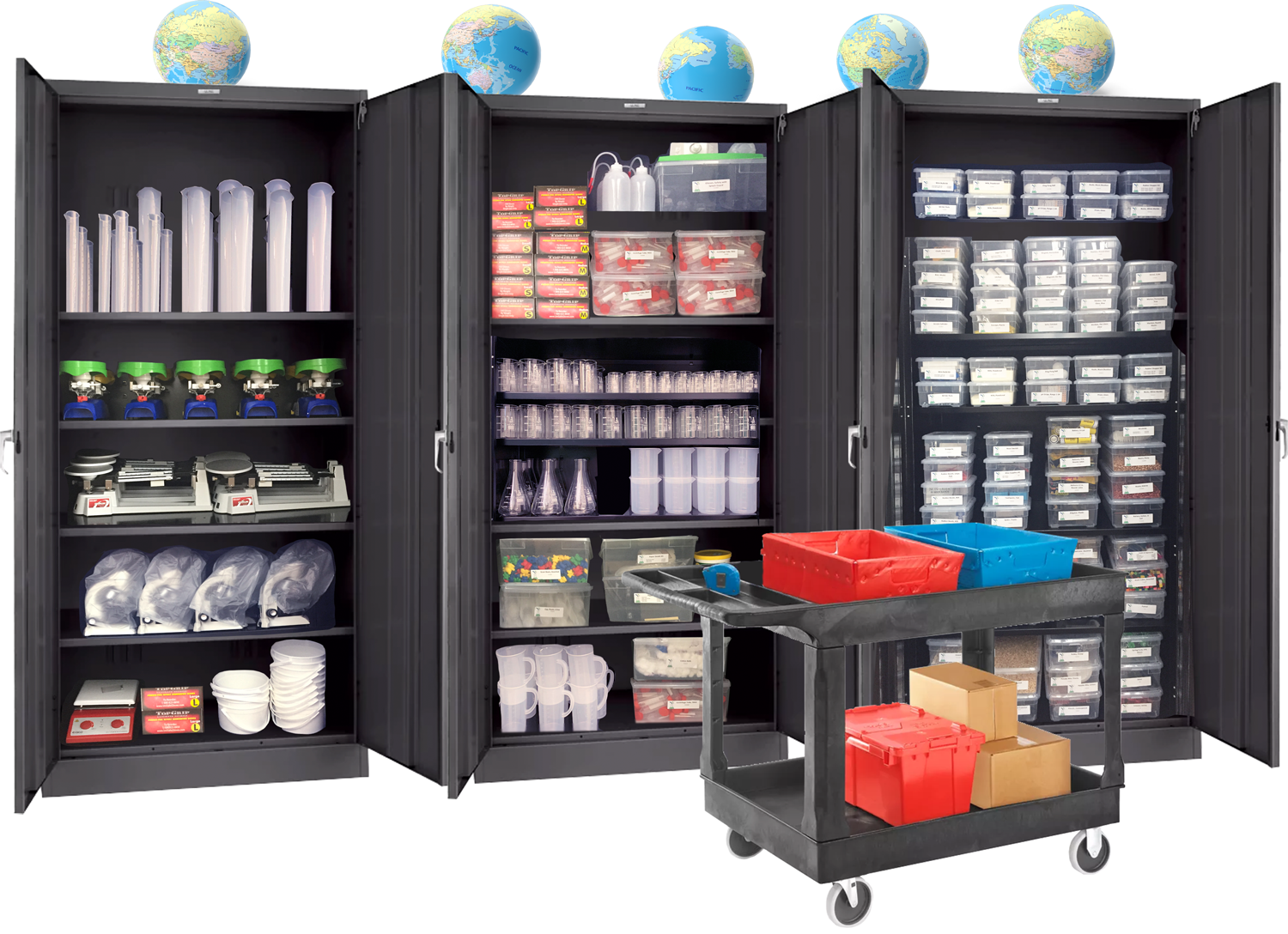
Scientific Thinking is Critical Thinking!
Science is Not Just a New Vocabulary and Way of Thinking, It's an Entirely Unique Skill Set
Walk into any LabLearner Explorer classroom and you will certainly observe scientific vocabulary both, written and oral, by every student. You will also see calculators out and students determining the average of several experimental trials. It’s impressive! However, what will likely stand out more than anything else is the presence and careful use of authentic science equipment. The following is a partial list of the types of materials LabLearner Explorer students use on a weekly basis:
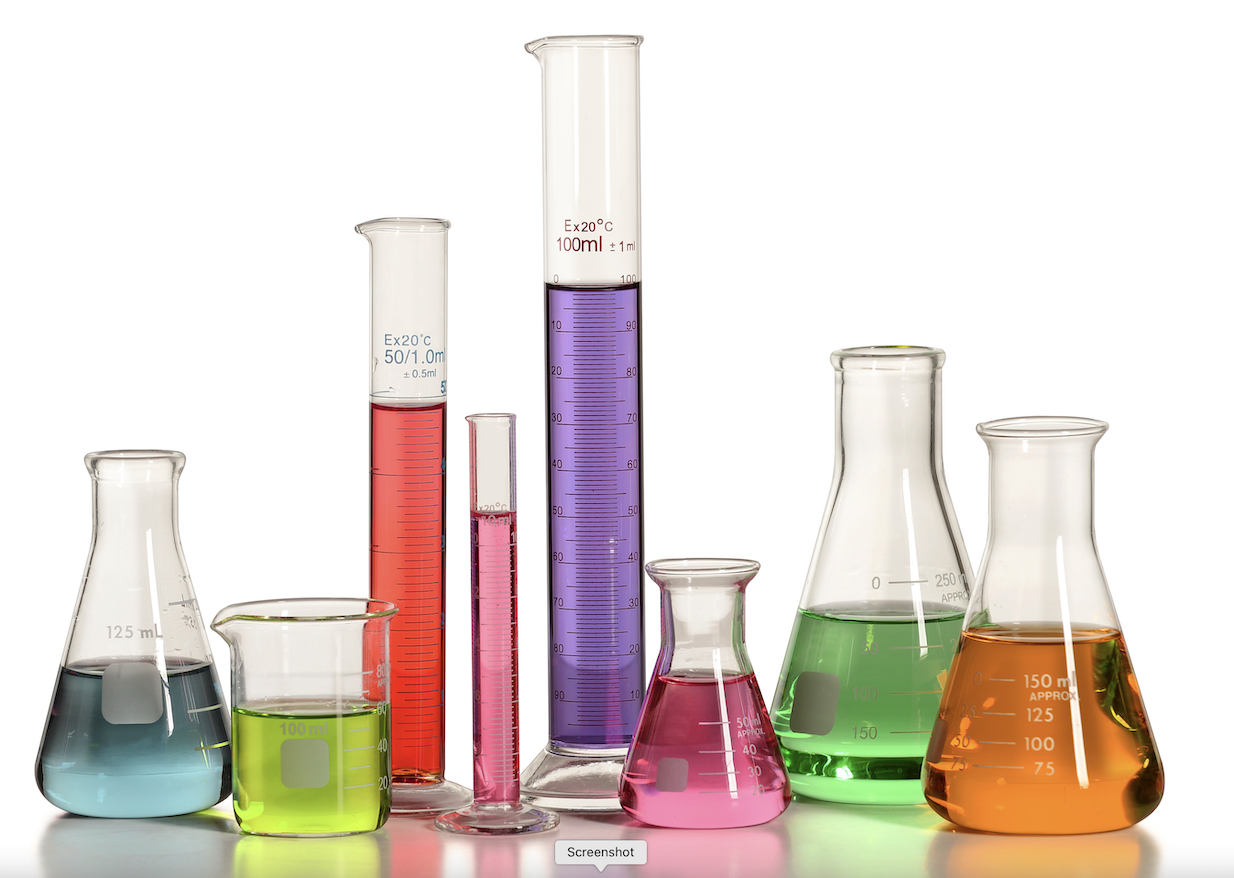 Meter Sticks
Meter Sticks- Pan Balances
- Triple Beam Balances
- pH Indicators
- Sring Scales
- Thermometers
- Compound Microscopes
- Beakers
- Flasks
- Hand Lenses
- Much More
The use of LabLearner instrumentation helps develop student fine motor control and visuospatial skills, but in LabLearner Explorer, we consider data analysis itself a scientific skill that Intermediate students can easily learn. In addition to skills gained by repeated and frequent use of instrumentation, LabLearner Explorer students also learn and regularly practice an array of data analysis tools:
- Calculation of Average Rate of Heat Transfer
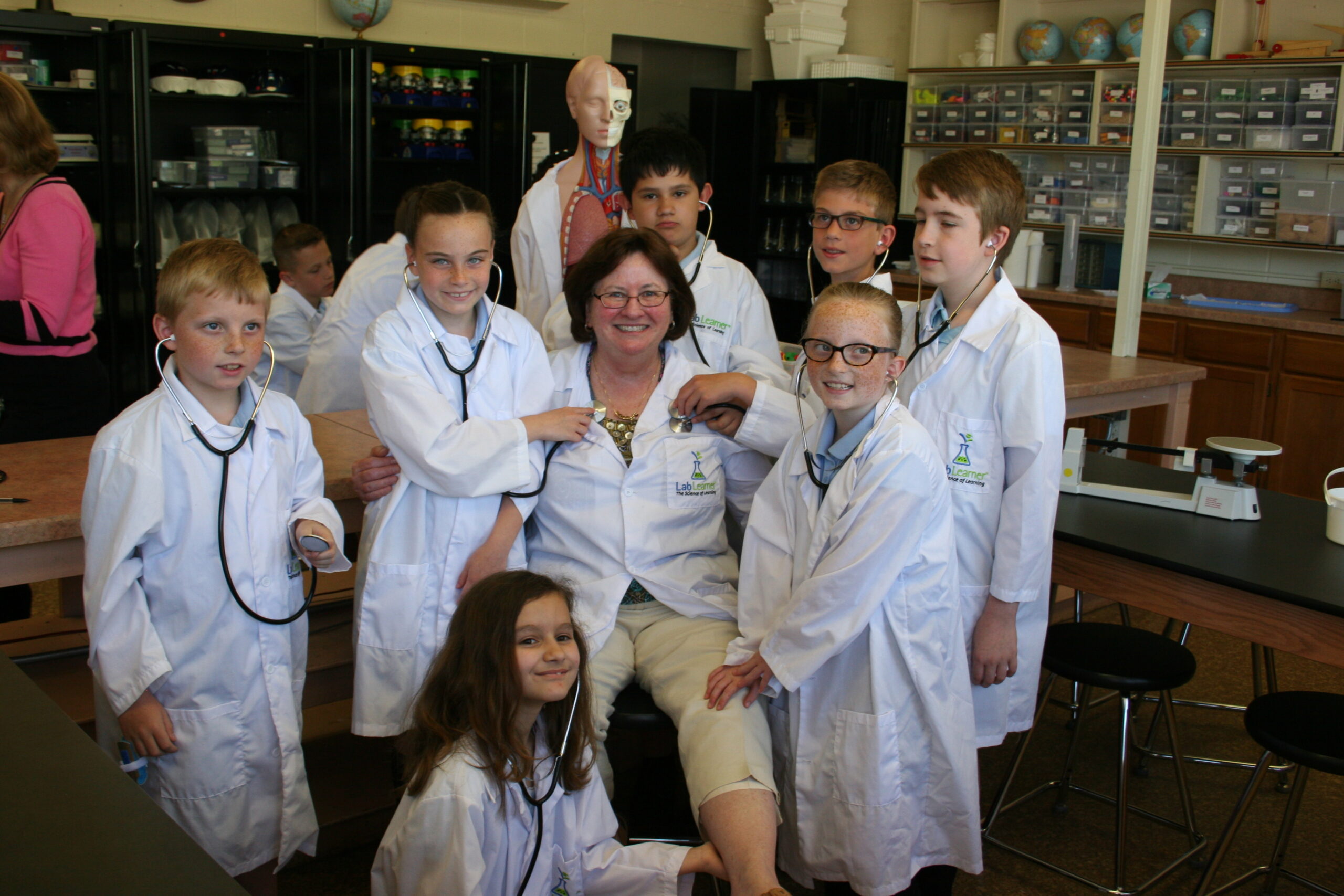
- Calculation of Density
- Creation and Completion of a Bar Graph
- Creation and Completion of a Data Table
- Creation and Completion of a Line Graph
- Creation and Completion of a Pie Graph
- Drawing a Best Fit Line
- Much More
All Assessments Included:
Authentic Performance Assessments, Unit Tests, and Weekly Quizzes
 Most educators and researchers agree that science should primarily be taught in a hands-on, experiential fashion. Thus, the baseline question for educators and researchers in the field of science education today is: What constitutes a good, successful science experience for students and how do we assess their performance? LabLearner believes that a wide variety of assessment tools should be used and that assessment must be done on a regular, frequent basis.
Most educators and researchers agree that science should primarily be taught in a hands-on, experiential fashion. Thus, the baseline question for educators and researchers in the field of science education today is: What constitutes a good, successful science experience for students and how do we assess their performance? LabLearner believes that a wide variety of assessment tools should be used and that assessment must be done on a regular, frequent basis.
LabLearner Explorer provides a PreTest and PostTest for every unit CELL as well as weekly quizzes. Teachers and curriculum directors can quantitatively gauge student mastery on a weekly basis.
Finally, formal Performance Assessments provide an opportunity for student lab groups to demonstrate their prowess in scientific thinking, problem-solving strategies, and laboratory skills under the authentic conditions of a lab setting – the best assessment paradigm available.
Digital Support and onging Teacher Professional Development
Teacher and Student Web Portals bring LabLearner Explorer Content and Support Anytime, Anywhere
 The LabLearner Explorer program comes with live teacher professional development to get teachers up and running immediately. In addition, job-embedded PD is built into every LabLearner Explorer unit CELL. Over one hundred curriculum-integrated teacher instructional videos are included so that teachers have weekly support. This is in addition to another 85 student-centered videos that are a component of weekly classroom lessons and available to students online through their own, password-protected LabLearner Explorer Student Portal, for review at any time from anywhere.
The LabLearner Explorer program comes with live teacher professional development to get teachers up and running immediately. In addition, job-embedded PD is built into every LabLearner Explorer unit CELL. Over one hundred curriculum-integrated teacher instructional videos are included so that teachers have weekly support. This is in addition to another 85 student-centered videos that are a component of weekly classroom lessons and available to students online through their own, password-protected LabLearner Explorer Student Portal, for review at any time from anywhere.
On To Middle School Science!
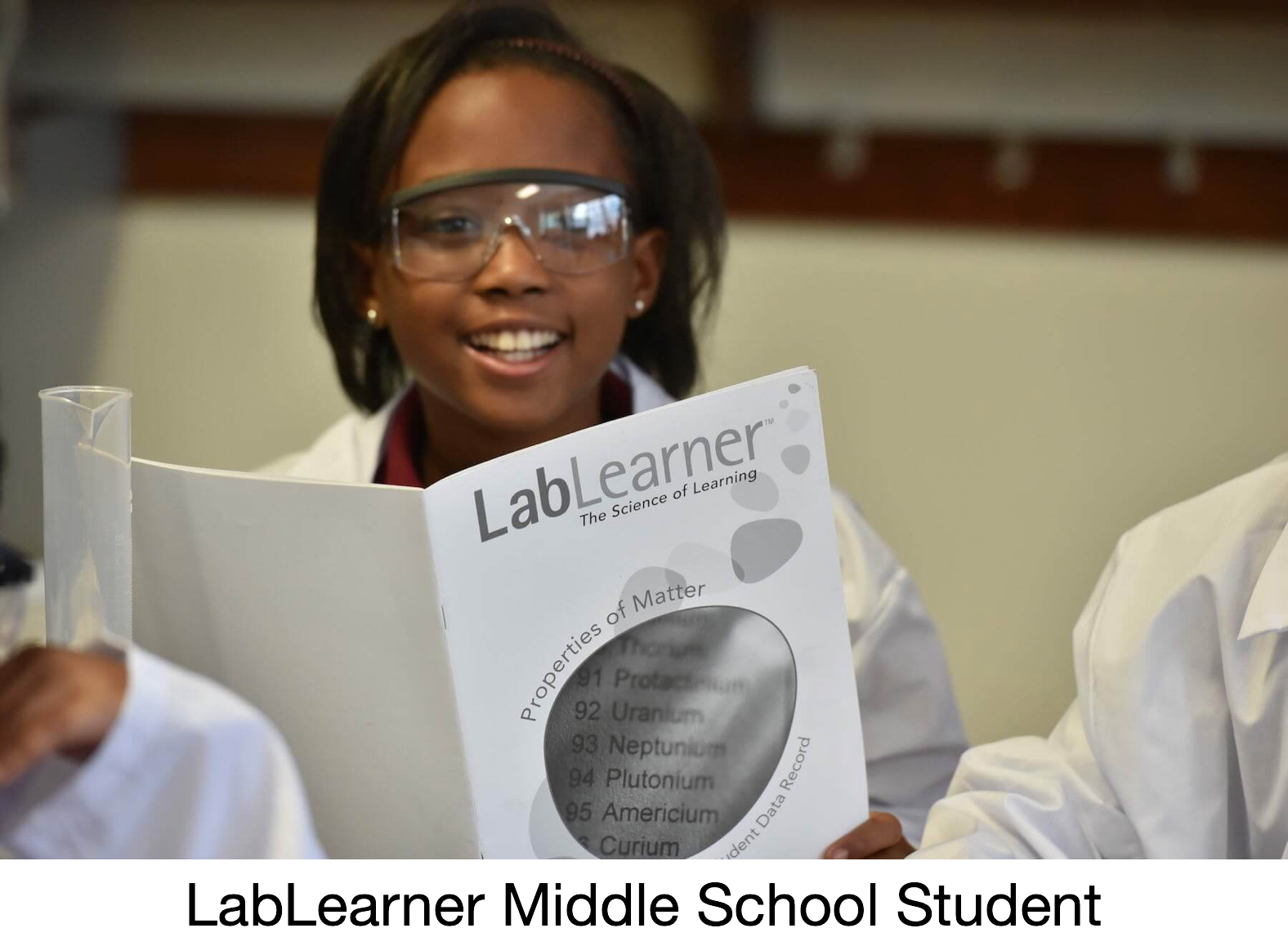 To say that LabLearner Explorer students leave fifth grade prepared for middle school science is an understatement.
To say that LabLearner Explorer students leave fifth grade prepared for middle school science is an understatement.
First, ALL data collection and analysis is strictly metric. At no time is the English system used in LabLearner Explorer. Therefore, LabLearner Explorer students enter middle school science with a solid grounding in metrics and an impressive list of analytic skills. For example:
- Mass is grams and kilograms
- Length in millimeters, centimeters, meters, and kilometers
- Volume in milliliters and liters
- Dependent and Independent variables
- Averaging data points to increase accuracy
- Prediction and hypothesis formulation and testing
- Collaborative and group laboratory skills and safety practices
- Much More
Expand LabLearner Explorer in Any Direction, at Any Time
The LabLearner Explorer Curriculum is Perfectly Embedded Between LabLearner Primary and LabLearner Middle School
One of the best features of the LabLearner Explorer program is that it permits schools to gain entry into the entire LabLearner K-8 program at a reasonable introductory cost and permits growth in either direction. Schools may choose to start with LabLearner Explorer for the many reasons discussed in the sections above. Schools can then easily expand to include the primary grades (K-2) or Middle School grades (6-8) – or both. In any case, the materials provided with LabLearner Explorer will be used in each of the additional grade levels. Thus, LabLearner Explorer presents the opportunity to test drive LabLearner at a reduced introductory cost and then apply the cost of the program towards upgrading to additional LabLearner grades.
- Low introductory cost
- Identical curricular structure as all other LabLearner grade levels
- Reduced cost when expanding into Primary or Middle School Lablearner
Finally, LabLearner Explore does NOT require a room dedicated to a LabLearner teaching laboratory. Therefore, schools pressed for space can begin LabLearner Explorer immediately. Alternatively, a school may begin LabLearner Explorer while a dedicated space for the full LabLearner program is in planning or preparation. Either way, your students win!

